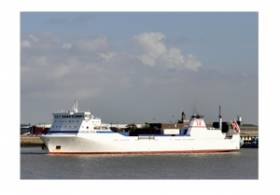Displaying items by tag: Stena North Sea Route
Added Freight Capacity on Stena Route to Europe via UK Landbridge
#FreightCapacity - Irish freight heading to and from mainland Europe via the UK landbridge will have additional freight capacity as Stena Line respond to demand on a North Sea route to the Netherlands.
The operator on the Killingholme-Rotterdam (Europoort and Hoek van Holland) route are to introduce a second ship from the Killingholme to Europoort. RoRo vessel Caroline Russ is to be enter service to operate three times weekly from Killingholme on the UK east coast to Europoort, with the first departure from the Dutch port on October 31.
The ship will join current RoRo ship, Stena Scotia (a former Irish Sea freightferry) on the route. The frequency will hereby increase to six departures per week in each direction. The Stena Scotia was introduced on the route September 2014 as a complement to the two freight ships, the Stena Transit and Stena Transporter on the Killingholme-Hoek van Holland route.
Annika Hult, Route Manager at Stena Line North Sea says: “We have seen a strong growth in the transport market to the UK over the past several years. We introduced our freight ship the Stena Scotia in 2014 in order to accommodate growing volumes of traffic. I am very pleased to announce that we will now take the next step in the strategic development of our Killingholme-Rotterdam (Europoort) route.”
“We expect trade to remain strong and want to be in the best place to service our customers and meet additional demands. Europoort continues to develop as an important freight hub for Stena Line and we are confident our customers will react positively to our expanded service”.
Facts: Caroline Russ
Type of ship: RoRo
Trailers: 102
Passengers: 12
Year of construction: 1999
Length: 153 m
Width: 20.6 m
Max speed: 20 kn





























































